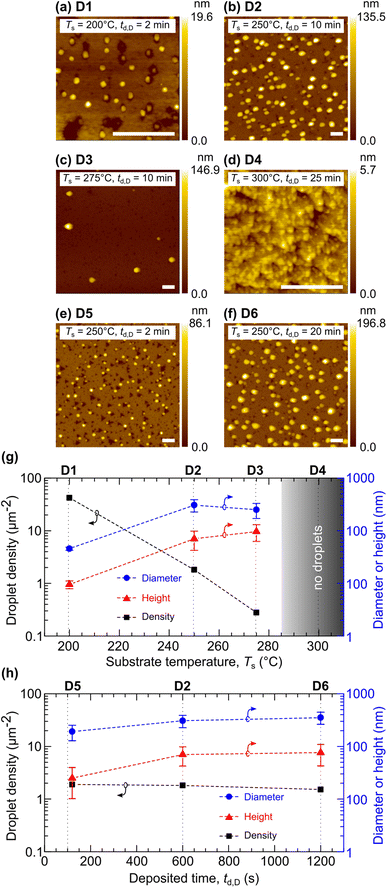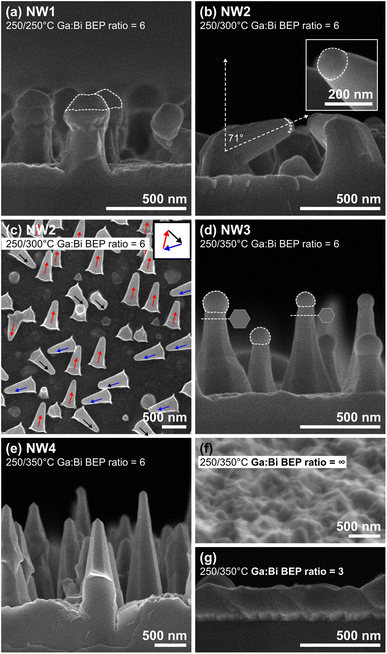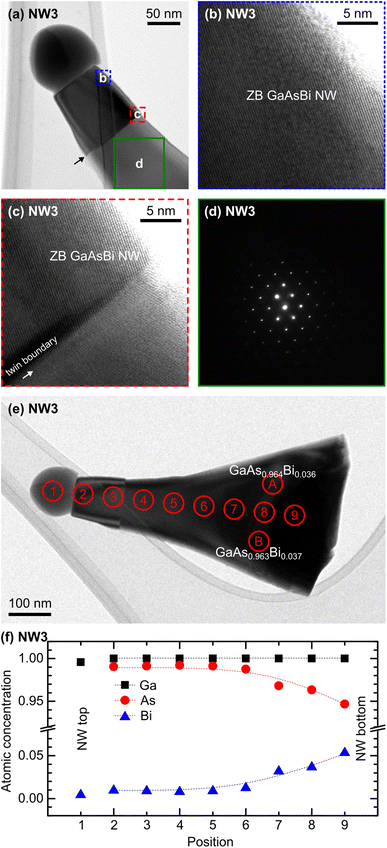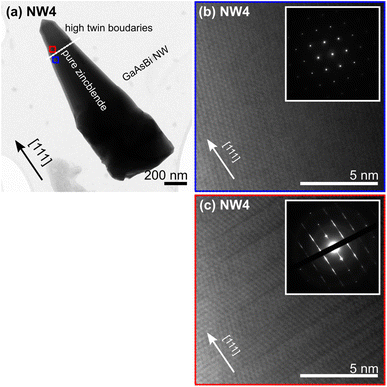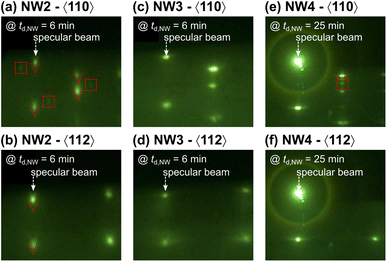 Open Access Article
Open Access ArticleCreative Commons Attribution 3.0 Unported Licence
High verticality vapor–liquid–solid growth of GaAs0.99Bi0.01 nanowires using Ga–Bi assisted catalytic droplets†
Chalermchai
Himwas
 *a,
Visittapong
Yordsri
b,
Chanchana
Thanachayanont
b,
Saharat
Chomdech
*a,
Visittapong
Yordsri
b,
Chanchana
Thanachayanont
b,
Saharat
Chomdech
 a,
Wenich
Pumee
a,
Somsak
Panyakeow
a and
Songphol
Kanjanachuchai
a,
Wenich
Pumee
a,
Somsak
Panyakeow
a and
Songphol
Kanjanachuchai
 a
a
aSemiconductor Device Research Laboratory, Department of Electrical Engineering, Faculty of Engineering, Chulalongkorn University, 254 Phayathai Road, Bangkok 10330, Thailand. E-mail: Chalermchai.H@chula.ac.th
bNational Metal and Materials Technology Center, Thailand Science Park, 114 Paholyothin Rd, Klong 1, Klong Luang, Pathumthani 12120, Thailand
First published on 8th November 2023
Abstract
GaAsBi nanowires (NWs) are promising for optoelectronic applications in the near- and mid-infrared wavelengths due to the optical properties of the Bi-containing compound and the nanowire structure benefits. In general, synthesizing the GaAsBi NWs results in uncontrollable metamorphic structures and spontaneous Bi-containing droplets. Here, we explore the potential of using the droplets as catalysts to form GaAsBi nanowires (hence, the vapor–liquid–solid growth mechanism) on GaAs (111) substrates by molecular beam epitaxy. The GaAsBi NWs experience a two-step growth: Bi droplet deposition and GaAsBi nanowire growth. The optimal droplet deposition temperature (250 °C) is defined based on the droplet morphologies. The gradation of growth temperatures of GaAsBi NWs to 250 °C, 300 °C, and 350 °C results in high-aspect-ratio NWs, tilted NWs, and low-aspect-ratio NWs, respectively. Structural investigation shows that the optimal (low-aspect-ratio) NW has the composition of GaAs0.99Bi0.01 with the catalytic droplet of Ga0.99Bi0.01 decorated on its tip. Detailed structural analyses show that the Bi content progressively increases from the NW stem to the wire–substrate interface. The satisfying GaAsBi NW morphology does not warrant the expected superior optical results. Photoluminescence study suggests that the NW has a strong carrier thermalization from the NW stem to the wire–substrate interface influenced by the graded NW growth temperature profile.
Introduction
GaAsBi is a relatively new class of III–V semiconductors with many key advantages. Adding Bi into a GaAs matrix can considerably reduce the band gap of the alloy (80–90 meV/Bi%)1–3 because GaBi is theoretically a semimetal.4 GaAsBi alloys have minimized Auger recombination loss5,6 from the energy difference between the valence band and spin–orbit-split-off band which is larger than the band gap. Moreover, the alloy also shows temperature stability.7 Despite the advantages, the optimal growth window for GaAsBi is narrow. The growth temperatures and the V/III flux ratios must be well-controlled8–13 to incorporate Bi atoms without triggering other challenges during the epitaxial growth, such as phase separation,14 surface droplets,15,16 and atomic ordering.17–19To enhance the performance of Bi-containing devices, quantum well (QW) or multiple-QW (MQW) structures are often employed since they can improve the optical response through carrier confinement. Most of the Bi-containing devices demonstrated are GaAs1−xBix QWs.20–24 It proves that low dimensionalities can further extend the performance of semiconductors, and nanowires (NWs) offer possibilities to grow on foreign substrates and to form heterostructures with minimized defect densities.25–29 Thus, many research groups have studied the radial and axial heterostructures of GaAs/GaAsBi NWs.30–33
However, reports on Bi-containing NWs are limited because of the growth challenges. Ishikawa et al. reported GaAs/GaAsBi core–shell NWs grown on Si (111). The GaAsBi shell has the maximum Bi content of 2% and was metamorphically grown around the GaAs core, resulting in a corrugated surface. They attributed the roughness to the lattice mismatch between the GaAs core and GaAsBi shell and the accumulated strain.30 The excess Bi atoms accumulated at the hexagonal vertices could act as catalysts for GaAsBi branches along the 〈112〉 directions.31 The shell compositional inhomogeneity and metamorphic structure exist even though the strain-balanced GaAs/GaAsPBi core–shell concept is applied.34 To obtain homogeneous GaAsBi NWs, one might need to incorporate Bi atoms through a vapor–liquid–solid (VLS) mechanism – the main focus of this work.
Here, we report a two-step technique to synthesize GaAsBi core nanowires on GaAs (111) substrates. The first step revolves around Bi pre-deposition at various growth temperatures/deposition times under an As overpressure to tune for an appropriate Bi amount and density at the growth front. In the second step, the varied growth temperatures and Ga–Bi beam equivalent pressure (BEP) ratios for GaAsBi NWs result in various NW morphologies, i.e., two-dimensional (2D)-like structure, tilted NWs, and vertical NWs. Detailed structural analyses were performed only on the morphology of interest – vertical NWs, confirming that the GaAsBi NWs crystallize by the VLS mechanism via Ga–Bi droplets. We briefly report the optical results for passivated GaAsBi core NWs compared to other Bi-containing structures. We associate the severe carrier thermalization with the vertically graded ternary alloy composition, which hinders the luminescence characteristics of the one-dimensional GaAsBi core NWs. Lastly, we suggest the growth conditions, adapted from the experiments, that might result in long-range GaAsBi core NWs with homogeneous compositions.
Experimental details
Epi-ready GaAs (111) substrates (AXT Inc.) were introduced into an ultra-high-vacuum (UHV) molecular beam epitaxy (MBE) system. The substrates were outgassed in the preheat chamber at 400 °C for 1 hour and were subsequently de-oxidized in the growth chamber at 600 °C for 30 min under an As-overpressure (BEPAs = 8 × 10−6 torr). The outgassed and de-oxidized processes expelled contaminants and oxides from the surfaces. The former outgassing in the preheat chamber minimized the introduction of possible contaminants into the growth chamber. The de-oxidation performed at the higher temperature and under an As-overpressure was to compensate for the sublimated As atoms from the surfaces. The substrate temperatures (Ts) were derived from a non-contact thermocouple temperature calibrated against the de-oxidation reflection high-energy electron diffraction (RHEED) pattern known to occur at 580 °C.After the de-oxidation process, Bi droplets were deposited on the GaAs (111) substrates. The deposition was performed by opening the Bi shutter (at BEPBi = 5 × 10−8 torr) under a constant As flux (BEPAs = 3.0 × 10−6 torr). The Bi droplets were deposited at various substrate temperatures (Ts = 200 (sample D1), 250 (D2, D5, and D6), 275 (D3), and 300 °C (D4)) with specific droplet deposition times (td,D). Table 1 presents the growth parameters and morphologies of the Bi droplets under study. The Bi deposition was performed in the Ts range of 200–300 °C under an As overpressure. The choice of the Ts range is made similar to those of Bi-containing materials while the BEPAs value was predetermined identical to the following growth sequence. Since our As flux is supplied by a sublimation cell, we cannot abruptly switch the BEPAs – the crucial parameter for fostering NWs. To overcome this challenge, we set the desired value of BEPAs before the deposition of Bi droplets and kept it constant until the NW growth was complete.
| Sample | Bi droplet deposition conditions | Droplet density (μm−2) | Diameter (nm) | Height (nm) | |
|---|---|---|---|---|---|
| T s (°C) | t d,D (min) | ||||
| D1 | 200 | 2 | 42 | 45.6 ± 3.2 | 9.6 ± 1.6 |
| D2 | 250 | 10 | 1.81 | 307.2 ± 80.0 | 70.2 ± 27.9 |
| D3 | 275 | 10 | 0.28 | 250.7 ± 79.4 | 96.8 ± 33.9 |
| D4 | 300 | 25 | — | — | — |
| D5 | 250 | 2 | 1.89 | 190.6 ± 62.5 | 25.0 ± 14.8 |
| D6 | 250 | 20 | 1.52 | 353.8 ± 91.9 | 76.0 ± 33.2 |
After the droplet deposition, the NWs were initiated by opening the Ga shutter at BEPGa = 3 × 10−7 torr, equivalent to a 2D deposition rate on GaAs (001) RGaAs of 0.57 nm s−1 as calibrated by RHEED oscillations. The BEPAs and BEPBi were kept identical to the previous stage. The GaAsBi NWs were grown with different substrate temperature ramping profiles. Samples NW1, NW2, and NW3 were grown during the temperature ramping from 250 °C to 250 °C (i.e., no ramping), 300 °C, and 350 °C, respectively. To explore the effect of the NW deposition time (td,NW), we also synthesized NW4, whose growth conditions are identical to NW3 except for the extended td,NW = 30 min.
For the optical study, we exclusively synthesized NW5. The sample experienced two more growth steps: droplet crystallization; and GaP shell radial growth. Because the GaAs surface has high surface recombination velocity35,36 and acts as non-radiative recombination centers, passivation with a higher band gap material (GaP) facilitates luminescence studies. For NW5, the NW growth conditions are identical to those for NW3/NW4, except for td,NW = 20 min. The droplet crystallization was performed by exposing GaAsBi NWs to only As flux (closing Ga and Bi shutters) for 15 min while keeping the Ts at 350 °C. After the droplet crystallization, Ts, BEPGa, and BEPP2 were set to 450 °C, 3.3 × 10−8 torr, and 6.6 × 10−7 torr, and then the P shutter (As shutter) was opened (closed). Growth interruption after the P shutter opening was carried out until the growth chamber pressure stabilized (∼10 min) to ensure the P overpressure. The GaP passivation was performed by opening the Ga shutter for 2 min 30 s. Table 2 presents the growth parameters and structural properties of the GaAsBi NW samples under study.
| Sample | GaAsBi NW deposition conditions | Bottom diameter (nm) | Top diameter (nm) | Height (μm) | |
|---|---|---|---|---|---|
| T s (°C) | t d,NW (min) | ||||
| NW1 | 250 | 6 | 283 | 268 | 0.47 |
| NW2 | 300 | 7 | 350 | 77 | 0.33 |
| NW3 | 350 | 6 | 256 | 113 | 0.49 |
| NW4 | 350 | 30 | 567 | 180 | 1.49 |
| NW5 | 350 | 20 | 388 | 212 | 0.85 |
The morphologies of the droplets were explored using tapping mode atomic force microscopy (AFM), while the structural information of the NWs was acquired using scanning electron microscopy (SEM). For detailed structural analyses, selected NWs were transferred onto a holey-carbon–copper grid. The NW structure and composition were analyzed by transmission electron microscopy (TEM, JEOL JEM-2010) equipped with energy-dispersed X-ray spectroscopy (EDS, OXFORD). Selected area diffraction patterns (SADPs) were recorded for crystallographic identification. TEM-EDS was probed at specific areas for elemental characterization. Optical characterization was performed by recording the photoluminescence (PL) spectra. Steady-state PL spectra were obtained by exciting the NWs with a Ventus solid-state laser (λ = 532 nm) and collecting the emission with a Horiba iHR320 monochromator equipped with a cooled (77 K) InGaAs photodetector.
Results and discussion
Bi droplets
During the Bi deposition, RHEED patterns changed from the GaAs (111) diffraction pattern to a dim reflection, confirming the Bi deposition. The RHEED pattern evolutions for samples D1, D3, D5, and D6 are provided in ESI S1.†Fig. 1(a)–(f) are the AFM images of samples D1–D6 depicting the Bi droplet morphologies. Their morphological parameters (diameter, height, and density) were extracted and are plotted in Fig. 1(g) and (h). Fig. 1(g) shows the variations of the morphological parameters as a function of Ts. Droplet diameters (droplet heights) for D1, D2 and D3 are 45.6 ± 3.2 (9.6 ± 1.6), 307.2 ± 80.0 (70.2 ± 27.9), and 250.7 ± 79.4 (96.8 ± 33.9) nm, respectively. The error bars represent the standard deviation of uncertainty. The distinct td,D value for D1 hinders the morphological comparison with the other two samples. The variations for D2 and D3 suggest that the deposition at higher Ts (with identical td,D) results in a lower droplet aspect ratio. The aspect ratio (defined as the ratio between the diameter and height) for D2 is 4.37, and that for D3 is 2.59. Despite the distinct td,D for D1, Fig. 1(g) shows that the Bi droplet density exponentially decreases with increasing Ts (from 42 droplets per μm2 at Ts = 200 °C to 0 droplets per μm2 at Ts = 300 °C). Baraissov et al. studied Ga metallic droplets deposited at various substrate temperatures and observed the same trend.37Fig. 1(h) shows the variations of the morphological parameters as a function of td,D with the identical Ts = 250 °C. Droplet diameters (droplet heights) for D5, D2, and D6 are 190.6 ± 62.5 (25.0 ± 14.8), 307.2 ± 80.0 (70.2 ± 27.9), and 353.8 ± 91.9 (76.0 ± 33.2) nm, respectively. The Bi droplet densities for D5, D2, and D6 are similar in the 1.52–1.89 droplets per μm2 range. These variations suggest that the droplet density varies consistently with Ts (Fig. 1(g)) while the td,D (Fig. 1(h)) controls the diameter and height.
Based on the results, one should deposit Bi droplets at Ts = 200–250 °C (below the Bi melting point at 271.4 °C) for a reasonable Bi droplet density. We chose to deposit the Bi droplets at Ts = 250 °C for td,D = 10 min, which results in 1.81 droplets per μm2 to proceed with the subsequent step of GaAsBi NW growth.
GaAs1−xBix nanowires
On this topic, we report the morphologies of GaAs1−xBix NWs grown at different Ts. NWs of interest were selected for detailed structural studies. At the end of this topic, we primitively discuss the luminescence behavior of GaAs1−xBix NWs.Fig. 2(a) shows a 90°-tiled SEM image of GaAsBi NWs with catalytic droplets on top (see white dashed peripheries). The average height of NW1 is 0.47 μm above the parasitic growth, and the average diameter is 275 nm. The wires grown with the identical Ts to that of Bi droplet deposition seem to have metamorphic structures yet develop along the [111] axis. Because the NW growth temperature is lower than the Bi melting point (∼271.4 °C), the liquid droplets that assisted the NW growth could be a Ga–Bi binary compound since its melting point decreases from that of the pure Bi case. NW2 has a tapered shape and a distinct orientation shown in Fig. 2(b) when the NW growth was performed simultaneously with the temperature increasing from 250 °C to 300 °C. NW2 has an average base diameter of 350 nm and an average height of 0.25 μm before switching its orientation. It is believed that the tilting occurred owing to wetting of the droplets at one of the NW facets during the growth temperature modification from a graded temperature to the fixed Ts = 300 °C, a mechanism similar to the effect of in situ annealing applied to control the GaAs NW direction,38 resulting in three possible directions as demonstrated in the top-view SEM image of sample NW2 (Fig. 2(c)). The tilting occurred only for NW2 with an angle of 71° normal to the surface. After the growth proceeds in a new direction, the NW diameter underneath the catalytic droplet is 143 nm. NW3 (NW4) has an average height of 0.49 μm (1.49 μm) above the parasitic growth, an average base diameter of 256 nm (567 nm), and an average top diameter of 113 nm (180 nm). Both samples have a 100% vertical yield, as depicted in Fig. 2(d) and (e). Catalytic droplets are evidenced for NW3 (white dashed peripheries), but no droplets were found for NW4. The droplets that disappear when increasing td,NW from 6 min (NW3) to 30 min (NW4) evolve similar to the Ga droplet-assisted VLS mechanism reported elsewhere.39,40 The growth mechanism switching and the pyramidal shape suggest that the ternary alloy NWs evolved under As-rich conditions. Indeed, we initially expected hexagonal prism GaAsBi NWs with the base diameter similar to the top diameter because the BEPAs/BEPGa value is 10, which is close to stoichiometric condition for the general growth of GaAs NWs by MBE. Here, the syntheses at comparatively lower temperatures decrease the As desorption from the growth fronts, resulting in more As atoms participating in the wire growth. To obtain the hexagonal prism shape for GaAsBi NWs grown at Ts = 350 °C, one needs to modify the BEPAs/BEPGa ratio. Furthermore, we proved that the amount of Bi atoms is critical for fostering the GaAsBi NWs at this low growth temperature. While all the NW samples were grown using BEPGa/BEPBi = 6, the micrographs for the growth without supplying Bi flux (BEPGa/BEPBi = ∞) and with BEPGa/BEPBi = 3 are consecutively demonstrated in Fig. 2(f) and (g), resulting only in the 2D-parasitic deposition.
Fig. 3(a) is a bright-field (BF-) TEM micrograph for NW3. The contrast shift (black arrow) at the NW middle suggests the crystal structure alteration. Individual analyses of NW3 show that the wire has a tapered shape with a base diameter of 324 nm and a top diameter of 91 nm. Fig. 3(b) and (c) are high-resolution (HR-) BF-TEM micrographs recorded at the ‘blue square’ and ‘red square’ regions delimited in Fig. 3(a), respectively. HR-BF-TEM micrographs confirm that the NW crystallized with a zinc blende structure with a single twin boundary (white arrow in Fig. 3(c)) over the entire NW length. Indeed, this is the only twin boundary found from several nanowires (NW3) submitted to detailed structural analyses. We also performed SADP over the selected area delimited by the ‘green square’ in Fig. 3(a). As shown in Fig. 3(d), the clear diffraction pattern implies a pure crystal phase over the large acquisition area.
TEM-EDS measurements were performed at various positions on the wire (see Fig. 3(e)), starting from the catalytic droplet marked as ‘1’ down to the NW bottom marked as ‘9’. Their corresponding Ga, As, and Bi atomic concentrations are plotted in Fig. 3(f). The alloy composition at the catalytic droplet (area ‘1’) is Ga0.996Bi0.004. Note that the ‘As-free’ at the droplet is crucial for this context as it proves that NW3 (also NW1 and NW2, where the catalytic droplets are shown earlier) evolved by the VLS mechanism catalyzed by the spherical liquid droplets. The ternary alloy compositions are stable from the area ‘2’ to ‘5’ at GaAs0.99Bi0.01. To the NW bottom, the As content (Bi content) continually decreases (increases) and reaches its minimum (maximum) at area ‘9’. The composition in this area is GaAs0.95Bi0.05. This compositional modification is associated with the temperature increment from 250 °C to 350 °C during the NW growth. The wire at the substrate proximity grown at 250 °C has a higher Bi content than the NW top section grown at 350 °C.
Cross-sectionally, the ternary alloy compositions probed at the areas ‘A’ and ‘B’ (see Fig. 3(e)) are GaAs0.964Bi0.036 and GaAs0.963Bi0.387, respectively. The similar contents confirm the benefit of the VLS mechanism, resulting in evenly distributed Bi atoms across the NW diameter and along the NW length (at a constant Ts), minimizing alloy inhomogeneity – the main challenge when incorporating Bi atoms in nanostructures. Detailed TEM-EDS compositional measurements are provided in ESI S2.†
Fig. 4(a) is a BF-TEM micrograph for NW4. Individual analyses of NW4 show that the wire has a tapered shape with a base diameter of 507 nm and a top diameter of 214 nm. The monotonous contrast at the NW stem and the alternating contrast at the NW tip in Fig. 4(a) suggest that the NW crystallized with different crystal phases at the two regions. HR-BF-TEM micrographs were performed at the ‘blue square’ and ‘red square’ regions to explore the crystal phase. The micrograph of the NW stem (NW4) oriented along the [111] direction and the corresponding SADP (Fig. 4(b)) reveal that the NW stem crystallized with the zinc blende (ZB) structure over the NW length. The micrograph of the NW and the corresponding SADP (Fig. 4(c)) reveal that the NW tip crystallized with a high density of twin planes normal to the growth axis. The excess As flux condition shirked the catalytic droplets until they were entirely crystallized for NW4 (the sample grown with a comparatively higher td,NW value). After the complete consumption of the droplets, the NW growth switched to the vapor–solid mechanism, which could result in a core–shell structure. The distinct compositions of the core and shell can disturb the compositional estimation. Thus, we only report the ternary alloy composition of NW3 where the catalytic droplets still exist, ensuring that the probed value belongs to the “core only” GaAsBi NW.
In situ RHEED patterns along the 〈110〉 and 〈112〉 azimuths for samples NW2, NW3, and NW4 are discussed against the reported morphologies. The RHEED diffraction intensity for NW1 dims (unshown), and various diffraction spots occur, possibly due to the large volume of amorphous liquid droplets on the growth front and a mixing structure during the NW initiation. Fig. 5(a) and (b) show the RHEED patterns of NW2 recorded along the 〈110〉 and 〈112〉 azimuths at td,NW = 6 min. More diffraction spots emerge along the 〈110〉 azimuth marked in Fig. 5(a) with red dashed squares. Typical diffraction spots along the 〈110〉 and 〈112〉 azimuths resulting from ZB NWs transform into chevrons as guided to eyes in Fig. 5(a) and (b) by red dashed chevrons. The emerged diffraction spots and diffraction transformation occurred only for NW2, which is associated with the tilted NWs. Fig. 5(c) and (d) show the RHEED diffraction patterns of NW3 recorded along the 〈110〉 and 〈112〉 azimuths at td,NW = 6 min. The NW deposition time is sufficiently short to preserve the catalytic droplets on the wire tips under the As-rich growth condition but long enough for the NWs to vertically evolve with the pure ZB crystal structure as confirmed in situ by the diffraction patterns. Fig. 5(e) and (f) show the RHEED diffraction patterns of NW4 recorded along the 〈110〉 and 〈112〉 azimuths at td,NW = 25 min. To the NW tips, the growth evolves with progressively lower droplet contact angle under As-rich conditions introducing a wurtzite (WZ) structure and polytypic phase before the droplets are entirely crystallized. According to the sequence, one should observe the WZ spots before the droplet is successfully consumed. The diffraction spot related to the WZ phase emerges after growing the NWs for more than 20 min (as marked with a red dashed square in Fig. 5(e)) overlayed on the diffraction pattern of the ZB structure, suggesting that the top part of NW4 contains both ZB and WZ structures, in agreement with the HR-TEM results (Fig. 4(a) and (c)). The RHEED patterns of GaAs NWs recorded along the 〈110〉 azimuth superposed with an indexation diagram can be found elsewhere for comparison.41
To study the luminescence of GaAs0.99Bi0.01 NWs, NW5 was exclusively synthesized by adapting from NW4 growth conditions. Droplets of NW5 were crystallized, and the GaAsBi cores were surrounded by thin GaP shells. Passivation with a higher band gap material facilitates luminescence studies34,42,43 since the GaAs surface has high surface recombination velocity35,36 and acts as a non-radiative recombination center.
Fig. 6(a) depicts the SEM image of NW5. Note that the RHEED patterns along the 〈110〉 azimuth during the NW growth step, droplet crystallization step, and passivation step are similar to those shown in the inset of Fig. 6(a) and identical to those of NW3 (Fig. 5(b)). It suggests that NW5 has a lower density (if any) of WZ or polytypic structures than NW4. Fig. 6(b) shows the photoluminescence spectra for NW5 measured at 30 K. Luminescence spectra ‘A’ and ‘B’ arise from the as-grown and the NW-scraped-out areas, respectively. Top-view SEM images for both positions are provided in ESI S3,† showing that the density for NW5 is 1.22 wire per μm2. The NW5 density is similar to the droplet density initiated at Ts = 250 °C (see Fig. 1(g) and (h)), suggesting that these wires emerged from the previously deposited droplets. The slight discrepancy is associated with the fact that some droplets do not evolve into NWs. Short NWs were not seen from the top-view SEM micrograph, hence excluded from the NW statistical analysis.
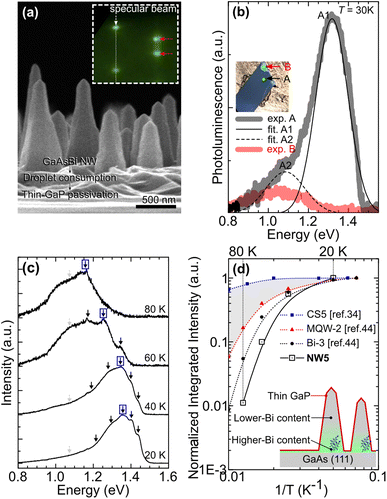 | ||
| Fig. 6 (a) 90°-Tilted SEM image of GaP-passivated GaAsBi nanowires (NW5). The inset shows the RHEED diffraction pattern along the 〈110〉 azimuth during the NW growth. (b) PL emission spectra of NW5 measured at 30 K. Black and red spectra are acquired from the as-grown area and NW-scraped-out area, respectively. (c) Temperature-dependent PL spectra measured from 20 K to 80 K. (d) Integrated PL intensity as a function of inverse temperature for NW5. For comparison, the PL peak evolutions for Bi-containing nanowires (blue squares, ref. 34), multiple quantum wells (red triangles, ref. 44), and bulk (black circles, ref. 44), are added in panel (d). | ||
Macroscopically, one can visually distinguish the two areas demonstrated in the inset of Fig. 6(b), where the green dots represent the laser spots during the luminescence acquisitions. The spectrum ‘A’ is fitted into two Gaussian peaks at 1.32 eV (peak A1) and 1.08 eV (peak A2), while the spectrum ‘B’ shows only one Gaussian peak at ∼1.1 eV. Since most of the wires were scraped out from ‘B’, leading to the formation of the two-dimensional parasitic material before the NW growth, the luminescence peak at ∼1.1 eV is associated with the parasitic growth on the surface. Henceforth, we exclude the luminescence peak at ∼1.1 eV from our GaAsBi NW luminescence discussion. Fig. 6(c) shows normalized PL spectra for NW5 measured at 20, 40, 60, and 80 K. GaAsBi NW luminescence spectra fitted into many Gaussians. We exclude the peaks marked with gray-dashed arrows (∼1.1 eV) from our optical analyses.
Fig. 6(d) shows the integrated PL intensity as a function of inverse temperature normalized to its value at 20 K. The integrated PL intensity drops very quickly. Comparing the normalized integrated intensity at 80 K (I80) against that at 20 K (I20), I80/I20 is 0.011. To further understand, we compare the result with other Bi-containing structures: bulk,44 multiple quantum wells,44 and nanowires.34 By the same criteria, I80/I20 values for Bi containing bulk, multiple-quantum wells, and nanowires are 0.05, 0.15, and 0.8, respectively. Theoretically, the NW should possess two-dimensional confinement behavior. Thus, we expected the I80/I20 to be higher than the one-dimensional confinement multiple quantum wells (I80/I20 = 0.15). Its integrated PL intensity evolution as a function of inverse temperature should lie in the shaded area in Fig. 6(d). In our case, the I80/I20 value for NW5 is even lower than that of Bi3 (bulk). It is because the generated carriers in the wire transfer to a band gap minima region (wire–substrate interface) at elevated temperatures before recombining (see the schematic demonstrated in Fig. 6(d)). The lower (higher) Bi concentration at the NW top (wire–substrate interface) as structurally evidenced in Fig. 3(e) and (f) creates the carrier thermalization channel that prohibits us from exploring the genuine optical behavior of one-dimensional GaAsBi NWs.
Conclusion
We have synthesized GaAsBi NWs by the VLS mechanism catalyzed by Ga–Bi droplets. The NWs have grown on GaAs (111) substrates by MBE using a two-step growth technique (Bi droplet predeposition and GaAsBi NW growth). We deposited Bi droplets for 10 min at the substrate temperature of 250 °C to obtain the suitable droplet morphologies to catalyze the NWs. By varying the graded NW growth temperatures from 250 °C to 250 °C, 300 °C, and 350 °C, the NW morphologies consecutively change to high-aspect-ratio NWs along the [111] axis, tilted NWs, and low-aspect-ratio NWs along the [111] axis respectively. Based on the high vertical yield and compositional information, we obtain the optimal GaAsBi NWs at the substrate temperature of 350 °C. Detailed structural analyses of the optimal NWs show that GaAsBi NWs crystallized with a pure ZB structure with the catalytic droplets on the NW tips. The graded NW growth temperature to 350 °C resulted in the homogeneous composition across the NW diameter and progressively lower Bi content from the bottom to the top of the NW, ending with a Ga0.99Bi0.01 droplet. The highest Bi content (lowest Bi content) probed at the NW/substrate interface (at the NW middle) is 0.05 (0.01). The photoluminescence peak measured at 20 K is 1.35 eV. However, we found that the wire has a strong carrier thermalization toward the wire–substrate interface supported by the structural results, which hinders the exploration of the wire's one-dimensional behavior. One may consider adjusting the V-to-III flux ratio or substrate temperature during the GaAsBi NW growth to minimize the carrier thermalization effect.Author contributions
Chalermchai Himwas: conceptualization, methodology, investigation, writing – original draft, writing – review & editing. Visittapong Yordsri: investigation. Chanchana Thanachayanont: investigation. Wenich Pumee: investigation. Somsak Panyakeow: resources. Songphol Kanjanachuchai: resources.Conflicts of interest
There are no conflicts to declare.Acknowledgements
This work was funded by the National Research Council of Thailand (N42A650261) and Grants for Development of New Faculty Staff, Ratchadaphiseksomphot Endowment Fund, Chulalongkorn University (Chalermchai Himwas).References
- S. Tixier, et al., Molecular beam epitaxy growth of GaAs1−xBix, Appl. Phys. Lett., 2003, 82, 2245–2247 CrossRef CAS.
- S. Francoeur, et al., Band gap of GaAs1−xBix, 0 < x < 3.6%, Appl. Phys. Lett., 2003, 82, 3874–3876 CrossRef CAS.
- K. Alberi, et al., Valence band anticrossing in GaBixAs1−x, Appl. Phys. Lett., 2007, 91, 051909 CrossRef.
- A. Janotti, S.-H. Wei and S. B. Zhang, Theoretical study of the effects of isovalent coalloying of Bi and N in GaAs, Phys. Rev. B: Condens. Matter Mater. Phys., 2002, 65, 115203 CrossRef.
- K. Alberi, et al., Valence-band anticrossing in mismatched III-V semiconductor alloys, Phys. Rev. B: Condens. Matter Mater. Phys., 2007, 75, 045203 CrossRef.
- M. Usman, C. A. Broderick, A. Lindsay and E. P. O'Reilly, Tight-binding analysis of the electronic structure of dilute bismide alloys of GaP and GaAs, Phys. Rev. B: Condens. Matter Mater. Phys., 2011, 84, 245202 CrossRef.
- K. Oe and H. Okamoto, New Semiconductor Alloy GaAs1−xBix Grown by Metal Organic Vapor Phase Epitaxy, Jpn. J. Appl. Phys., 1998, 37, L1283–L1285 CrossRef.
- X. Lu, D. A. Beaton, R. B. Lewis, T. Tiedje and M. B. Whitwick, Effect of molecular beam epitaxy growth conditions on the Bi content of GaAs1−xBix, Appl. Phys. Lett., 2008, 92, 192110 CrossRef.
- W. Pan, L. Wang, Y. Zhang, W. Lei and S. Wang, MBE growth strategy and optimization of GaAsBi quantum well light emitting structure beyond 1.2 μm, Appl. Phys. Lett., 2019, 114, 152102 CrossRef.
- R. B. Lewis, M. Masnadi-Shirazi and T. Tiedje, Growth of high Bi concentration GaAs1−xBix by molecular beam epitaxy, Appl. Phys. Lett., 2012, 101, 082112 CrossRef.
- K. Oe, Metalorganic vapor phase epitaxial growth of metastable GaAs1−xBix alloy, J. Cryst. Growth, 2002, 237–239, 1481–1485 CrossRef CAS.
- H. Fitouri, I. Moussa, A. Rebey, A. Fouzri and B. El Jani, AP-MOVPE of thin GaAs1−xBix alloys, J. Cryst. Growth, 2006, 295, 114–118 CrossRef CAS.
- I. Moussa, H. Fitouri, A. Rebey and B. El Jani, Atmospheric-pressure metalorganic vapour phase epitaxy optimization of GaAsBi alloy, Thin Solid Films, 2008, 516, 8372–8376 CrossRef CAS.
- M. Wu, E. Luna, J. Puustinen, M. Guina and A. Trampert, Formation and phase transformation of Bi-containing QD-like clusters in annealed GaAsBi, Nanotechnology, 2014, 25, 205605 CrossRef.
- E. Sterzer, et al., Investigation of the microstructure of metallic droplets on Ga(AsBi)/GaAs, J. Cryst. Growth, 2014, 408, 71–77 CrossRef CAS.
- C. R. Tait, L. Yan and J. M. Millunchick, Droplet induced compositional inhomogeneities in GaAsBi, Appl. Phys. Lett., 2017, 111, 042105 CrossRef.
- A. G. Norman, R. France and A. J. Ptak, Atomic ordering and phase separation in MBE GaAs1−xBix, J. Vac. Sci. Technol., B: Nanotechnol. Microelectron.: Mater., Process., Meas., Phenom., 2011, 29, 03C121 Search PubMed.
- D. F. Reyes, et al., Bismuth incorporation and the role of ordering in GaAsBi/GaAs structures, Nanoscale Res. Lett., 2014, 9, 23 CrossRef PubMed.
- A. Beyer, et al., Local Bi ordering in MOVPE grown Ga(As,Bi) investigated by high resolution scanning transmission electron microscopy, Appl. Mater. Today, 2017, 6, 22–28 CrossRef.
- R. Butkutė, et al., Multi-quantum well Ga(AsBi)/GaAs laser diodes with more than 6% of bismuth, Electron. Lett., 2014, 50, 1155–1157 CrossRef.
- P. Ludewig, et al., Electrical injection Ga(AsBi)/(AlGa)As single quantum well laser, Appl. Phys. Lett., 2013, 102, 242115 CrossRef.
- I. P. Marko, et al., Physical properties and optimization of GaBiAs/(Al)GaAs based near-infrared laser diodes grown by MOVPE with up to 4.4% Bi, J. Phys. D: Appl. Phys., 2014, 47, 345103 CrossRef.
- H. Kim, et al., Strain-compensated GaAs1−yPy/GaAs1−zBiz/GaAs1−yPy quantum wells for laser applications, Semicond. Sci. Technol., 2015, 30, 094011 CrossRef.
- H. Kim, Y. Guan, K. Forghani, T. F. Kuech and L. J. Mawst, Laser diodes employing GaAs1−xBix/GaAs1−yPy quantum well active regions, Semicond. Sci. Technol., 2017, 32, 075007 CrossRef.
- L. J. Lauhon, M. S. Gudiksen, D. Wang and C. M. Lieber, Epitaxial core–shell and core–multishell nanowire heterostructures, Nature, 2002, 420, 57–61 CrossRef CAS PubMed.
- M. T. Björk, et al., One-dimensional Steeplechase for Electrons Realized, Nano Lett., 2002, 2, 87–89 CrossRef.
- Y. Liang, W. D. Nix, P. B. Griffin and J. D. Plummer, Critical thickness enhancement of epitaxial SiGe films grown on small structures, J. Appl. Phys., 2005, 97, 043519 CrossRef.
- F. Glas, Critical dimensions for the plastic relaxation of strained axial heterostructures in free-standing nanowires, Phys. Rev. B: Condens. Matter Mater. Phys., 2006, 74, 121302 CrossRef.
- K. L. Kavanagh, Misfit dislocations in nanowire heterostructures, Semicond. Sci. Technol., 2010, 25, 024006 CrossRef.
- F. Ishikawa, et al., Metamorphic GaAs/GaAsBi Heterostructured Nanowires, Nano Lett., 2015, 15, 7265–7272 CrossRef CAS.
- T. Matsuda, et al., Controlling Bi-Provoked Nanostructure Formation in GaAs/GaAsBi Core–Shell Nanowires, Nano Lett., 2019, 19, 8510–8518 CrossRef CAS.
- M. Oliva, G. Gao, E. Luna, L. Geelhaar and R. B. Lewis, Axial GaAs/Ga(As, Bi) nanowire heterostructures, Nanotechnology, 2019, 30, 425601 CrossRef CAS PubMed.
- B. Zhang, et al., Effects of Bi incorporation on recombination processes in wurtzite GaBiAs nanowires, Nanotechnology, 2020, 31, 225706 CrossRef CAS.
- C. Himwas, et al., GaAs/GaAsPBi core-shell nanowires grown by molecular beam epitaxy, Nanotechnology, 2022, 33, 095602 CrossRef CAS PubMed.
- J. Lloyd-Hughes, et al., Influence of surface passivation on ultrafast carrier dynamics and terahertz radiation generation in GaAs, Appl. Phys. Lett., 2006, 89, 232102 CrossRef.
- H. J. Joyce, et al., Electronic properties of GaAs, InAs and InP nanowires studied by terahertz spectroscopy, Nanotechnology, 2013, 24, 214006 CrossRef PubMed.
- Z. Baraissov, F. Panciera, L. Travers, J.-C. Harmand and U. Mirsaidov, Growth Dynamics of Gallium Nanodroplets Driven by Thermally Activated Surface Diffusion, J. Phys. Chem. Lett., 2019, 10, 5082–5089 CrossRef CAS PubMed.
- E. S. Koivusalo, et al., Deterministic Switching of the Growth Direction of Self-Catalyzed GaAs Nanowires, Nano Lett., 2019, 19, 82–89 CrossRef CAS PubMed.
- F. Jabeen, V. Grillo, S. Rubini and F. Martelli, Self-catalyzed growth of GaAs nanowires on cleaved Si by molecular beam epitaxy, Nanotechnology, 2008, 19, 275711 CrossRef.
- C. Colombo, D. Spirkoska, M. Frimmer, G. Abstreiter and A. Fontcuberta i Morral, Ga-assisted catalyst-free growth mechanism of GaAs nanowires by molecular beam epitaxy, Phys. Rev. B: Condens. Matter Mater. Phys., 2008, 77, 155326 CrossRef.
- T. Dursap, et al., Crystal phase engineering of self-catalyzed GaAs nanowires using a RHEED diagram, Nanoscale Adv., 2020, 2, 2127–2134 RSC.
- C. Himwas, et al., In situ passivation of GaAsP nanowires, Nanotechnology, 2017, 28, 495707 CrossRef CAS.
- C. Himwas, et al., Correlated optical and structural analyses of individual GaAsP/GaP core–shell nanowires, Nanotechnology, 2019, 30, 304001 CrossRef CAS PubMed.
- C. Himwas, et al., Optical properties of lattice-matched GaAsPBi multiple quantum wells grown on GaAs (001), Semicond. Sci. Technol., 2021, 36, 045014 CrossRef CAS.
Footnote |
| † Electronic supplementary information (ESI) available. See DOI: https://doi.org/10.1039/d3na00428g |
| This journal is © The Royal Society of Chemistry 2024 |

